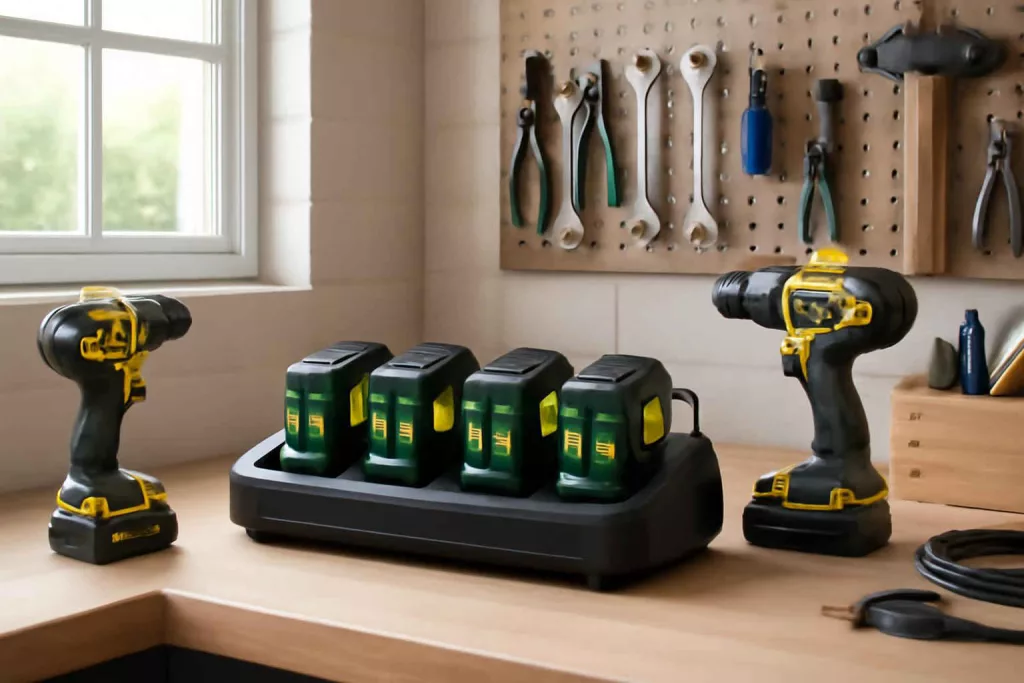Keeping multiple cordless tool batteries fully charged and ready for your next DIY or professional project can be a challenge. A reliable portable power tool battery charging station simplifies this process by centralizing your charging needs. With features like multi-bay charging, fast-charge modes, and compact designs, these stations are a must-have for any workshop or job site. If you want to extend the life of your power tool batteries, pairing them with the right charging station makes a world of difference.
In this comprehensive guide, we’ll explore why a portable battery charger station is essential for homeowners and professionals, the key features to look for, our top six picks, installation and setup advice, and maintenance tips to keep your station in peak condition.
Why a Portable Charging Station Is Essential
For contractors, hobbyists, and DIY enthusiasts, productivity often hinges on battery availability. Instead of plugging each battery into separate chargers, a multi-battery station streamlines charging, reducing downtime. Midway through a job, waiting for a single charger can slow progress. A station with multiple bays ensures you always have at least one battery on standby.
Moreover, many stations offer advanced features like rapid charging, automatic charge leveling, and LED indicators to monitor progress. These simplify battery management by automatically switching to a trickle charge once batteries are full, maintaining them at peak health until you’re ready to use them. When paired with proper battery maintenance strategies, such as those in our battery maintenance guide, you’ll see longer runtimes and fewer unexpected dead batteries on the job site.
Key Features to Consider
Number of Charging Bays
More bays mean you can top up additional batteries simultaneously. Entry-level stations typically offer two to four bays, while professional units can handle six or more. If you own multiple tools from the same brand, matching the bay count to your toolkit size helps avoid bottlenecks.
Compatibility
Check that the charging station supports the battery series you use. Leading brands like DEWALT, Makita, and Milwaukee often lock you into their ecosystems. Some universal chargers work across multiple brands, but they may charge at a slower rate or lack brand-specific safety features.
Charging Speed and Modes
Rapid-charge modes can refill a battery to 80% more quickly, then switch to a trickle charge for safety. Look for stations with smart technology that adapts charging currents based on battery state of health, preventing overcharging.
Portability and Build Quality
A compact footprint and sturdy housing make a difference on a crowded workbench or mobile job site. Rubberized grips, integrated cable wrap, and lightweight design enhance portability. Weather-resistant models offer extra durability on outdoor projects.
Top 6 Portable Power Tool Battery Charging Stations
1. DEWALT DCB115 Multi-Voltage Charger
The DEWALT DCB115 accommodates 12V, 20V Max, and 60V batteries in a four-bay layout. Its fast-charge mode delivers up to 4 amps per bay, refilling a 20V 5Ah battery in under 60 minutes. LED bars indicate each battery’s status. The station features an integrated handle and cable management, making it easy to transport between shop and site. Buy it on Amazon: DEWALT DCB115.
2. Makita DC18RD Dual-Station Rapid Charger
The Makita DC18RD supports dual-port charging for 18V LXT batteries. Boasting dual LED charging indicators and a built-in protection circuit, it prevents overcharging and overheating. Its compact design and rubberized feet ensure stability on uneven surfaces. It’s ideal if you primarily use Makita tools and need a dependable workhorse. Get it here: Makita DC18RD.
3. Milwaukee M18 & M12 Multi-Voltage Charger (Model 48-59-1812)
Milwaukee’s Model 48-59-1812 can charge both M12 and M18 batteries, perfect for users of mixed-voltage Milwaukee tools. Its diagnostic mode identifies battery faults, extending overall battery lifespan by flagging weak cells. The charger has four bays and intuitive LED status rings around each slot. Learn more: Milwaukee 48-59-1812.
4. Bosch GAL 4-16 Professional Multi Charger
Bosch’s GAL 4-16 can handle four 12V to 18V lithium-ion batteries simultaneously. Its staggered charging algorithm ensures heat management, stretching battery life. The unit includes a built-in 110V outlet pass-through, allowing you to power other devices from the charger’s AC input—ideal for small job site setups. Check it out: Bosch GAL 4-16.
5. Ryobi P1819 18V ONE+ Dual Bay Charger
The Ryobi P1819 offers dual-bay charging for the popular 18V ONE+ line. While limited to two bays, it compensates with user-friendly LEDs and a compact footprint under 6 inches wide. It’s budget-friendly and compatible with all Ryobi 18V batteries, making it a great starter station. Purchase here: Ryobi P1819.
6. Portercable PCC780B Flexi-Charger
Porter-Cable’s Flexi-Charger features a rotating head for easy placement in tight spaces and can handle 12V, 20V, and 60V Max batteries. Its four charging bays can be oriented vertically or horizontally. The rugged housing and integrated cable clip make it workshop-friendly. Find it on Amazon: Porter-Cable PCC780B.
Installation and Setup Tips
Begin by choosing a stable, level surface near a grounded outlet. Keep at least 4 inches of clearance around the station to ensure proper ventilation. If possible, mount a small shelf above your workbench to free up bench space. Use cable ties or integrated wraps to secure power cords and avoid trip hazards.
To protect your chargers from dust and debris in a busy workshop, install a low-profile cover or clear acrylic shield that doesn’t obstruct airflow. For mobile setups, consider a rolling utility cart with a dedicated compartment for your charging station. You can even pair it with a DIY power tool charging station project to customize your workflow.
Maintenance and Safety Tips
Regularly inspect charging bays for dust build-up or debris. Unplug the station before cleaning, and use a soft brush to clear contact points. Check power cords for frays or damage; replace immediately if you find any wear. Avoid storing batteries on the station when not in use—disconnect them to prevent unnecessary trickle charging and potential over-discharge.
Follow manufacturer recommendations for battery storage temperature and humidity. Extreme heat or cold can degrade lithium-ion cells. When not charging, store batteries at 40–60% state of charge and in a dry, temperature-controlled environment. For more in-depth battery care, refer to our complete battery maintenance guide.
Conclusion
Investing in the right portable power tool battery charging station streamlines your workflow, reduces downtime, and prolongs battery life. From multi-brand compatibility to rapid-charge features, the six picks above cater to various budgets and tool ecosystems. Proper installation, coupled with regular maintenance and our battery care tips, will ensure you get the most out of your investment. Ready to upgrade your charging setup? Explore our top picks and keep your tools powered up for every project.






